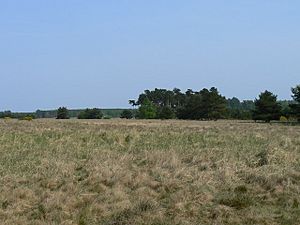Breckland facts for kids

Breckland is a very special natural area in England, found mostly in Norfolk and a bit in Suffolk. It's a huge area, about 39,433 hectares, which is protected because of its unique wildlife, especially birds. It's known for its sandy heathland covered in gorse bushes. You'll also see lots of Scots pine trees here.
Breckland is one of the driest places in England. It's super interesting because it has many unusual plants and animals that you won't find easily elsewhere. It sits near other cool habitats like the Fens and the Broads.
Long ago, people mined flint here, and you can still see signs of this at Grime's Graves. The word 'Breck' comes from medieval times and means an area of heathland that was farmed for a while, then left to return to nature. For a long time, much of Breckland was open heathland.
Today, the Brecks are a popular place for visitors. They are also very important for scientists who study nature and geography. The area is so special that a local government area, Breckland District, is named after it.
Contents
Exploring the Brecks
You can explore the eastern part of Breckland by walking or cycling the Great Eastern Pingo Trail. This trail is about 8 miles long and takes you through different landscapes. You'll see commons (shared open spaces) near villages like Thompson and Stow Bedon. You'll also pass through heathland at Breckles and Great Hockham.
The trail also goes by Thompson Water, which is an artificial lake, and through the woodlands at Thompson Carr. The trail gets its name from an old railway line and the many "pingo ponds" you'll find there.
What are Pingo Ponds?
Pingo ponds, also called kettle lakes, are really cool! They formed when huge sheets of ice melted a long, long time ago. As the ice melted, mounds of earth-covered ice collapsed, leaving behind these unique ponds. You can even connect to the Pingo Trail from the Peddars Way long-distance path. It's a Local Nature Reserve, meaning it's protected for its natural beauty.
Amazing Wildlife of Breckland
Even though Breckland has changed a lot over the last 50 years, it's still a safe home for many rare and threatened animals and plants. A big part of Breckland (43%) is protected by national or international laws because of its wildlife and interesting geology.
Over 12,845 different types of species live in the Brecklands! This makes it one of the most important places for wildlife in the UK. You can find special birds here like nightjars, woodlarks, and a huge 65% of the UK's stone curlew population. Sadly, some species that used to live here, like certain flowers, mosses, beetles, and moths, are now gone from the area.
Rare Plants and Animals
The Brecklands are home to more than 120 plant species that are rare or threatened across the country. Many of these plants grow nowhere else in Britain! Because of all this amazing variety, Breckland is recognized internationally as an Important Plant Area (IPA). Many of the unique plants and animals here have special protection. There are also projects to help them thrive, sometimes by letting nature take its course, which is called rewilding.
Animals that are carefully watched in Breckland include the woodlark, stone curlews, grey carpet moth, lunar yellow under-wing moth, nightjars, brush-thighed seed-eater beetle, forester moth, moonshiner beetle, and five-banded tailed digger wasp. Some of the rare or endangered plants you might find are Spanish Catchfly, Spring Speedwell, Tower Mustard, Rare Spring-sedge, Red-tipped Cudweed, Field Wormwood, Prostrate Perennial Knawel, Fingered Speedwell, Military Orchid, Proliferous Pink, Bee Orchid, Fine-leaved Sandwort, and Grape Hyacinth.
Challenges for Wildlife
A lot of the original Breckland heathland has been lost. Between 1934 and 1980, about 86% of it disappeared. Huge areas were planted with conifer trees to create forests, and many heaths were ploughed up for farming. Also, fewer sheep and cattle graze the land now, and rabbit numbers dropped a lot when a disease called myxomatosis arrived in 1954.
Because of these changes, and less bracken and heather being collected, large parts of the heath have become very overgrown. This makes it hard for the special plants that like open, disturbed land to grow. Even the open sand dune areas have become overgrown, so the sand doesn't move around in the wind as much as it used to.
Good news though! A project started in 2005 to bring back the Pool Frog (Pelophylax lessonae) to Breckland. Also, Breckland is one of the few places in England where you might spot the rare and shy golden pheasant living in the wild, even though it's not originally from here.
Gallery












